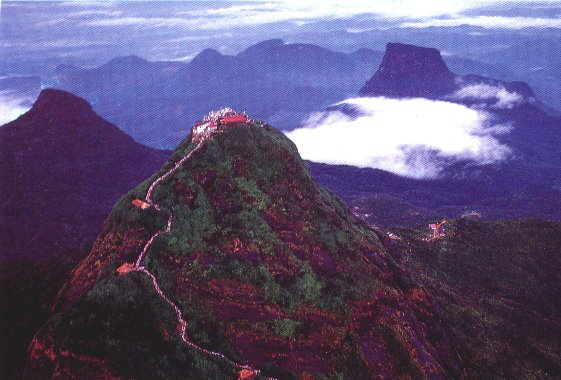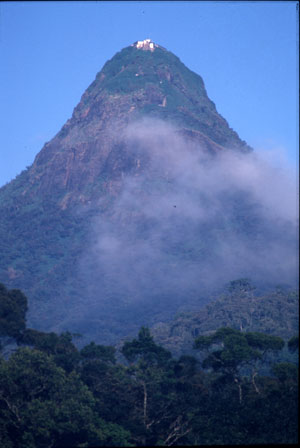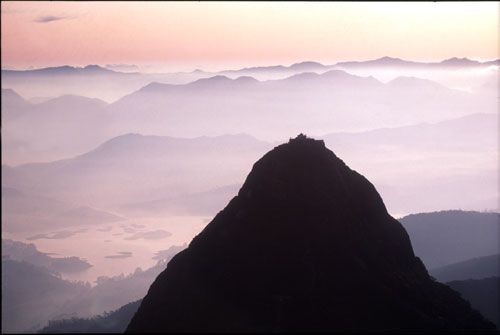Adam's Peak (Sri Paadaya)

Adam's Peak - One of the places where Lord Buddha stepped during the visit to Sri Lanka. Also known as Sri Paadaya.
Sri Pada: The Legend
An ancient pilgrimage, which has long attracted thousands of pilgrims from perhaps all faiths, is the pilgrimage to the sacred mountain, Sri Pada, popularly known in English as Adam's Peak. It is a conical mountain 7,360 feet (2,243 meters) high, soaring clear above the surrounding mountain ranges. According to a legend, when the Buddha visited Ceylon he planted one foot on the north of the royal city and the other on Sumana-kuta (Adam's Peak) fifteen yojanas, or about hundred miles distant.
According to another legend the Buddha is believed to have left the print of his left foot on Adam's Peak, and then, in one stride, strode across to Siam, (now Thailand) where he left the impression of his right foot. It is called Phra Sat, and its appearance is supposed to be like that of the foot print on Adam's Peak and of similar size.
General Sir A. Cunningham, in his account of the Bharhut Stupa, which dates from the second century B.C., says:
"Footprints of Buddha were most probably an object of reverence from a very early period -- certainly before the building of the Bharut Stupa -- as they are represented in two separate sculptures there. In the sculpture the foot≠prints are placed on a throne or altar, canopied by an umbrella hung with gar≠lands. A royal personage is kneeling before the altar, and reverently touching the footprints with his hands. The second example is in the bas-relief repre≠senting the visit of Ajata-satru to Buddha. Here, as in all other Bharut sculp≠tures, Buddha does not appear in person, his presence being marked by his two footprints. The wheel symbol is duly marked on both' (p. 112. abridged).

The Footprint
On the top of the Peak broad steps lead up to a walled enclosure containing the rock over which is a tower-like structure. The portion marked off as having the imprint of the Buddha's foot is about five feet seven inches long and two feet seven inches broad. The hole in the rock in Thailand, which is believed to have the imprint of the Buddha's right foot, is about five feet long and two feet broad. Buddhists attribute this universal size to the fact (such is the belief) that the Buddha was about thirty-five feet tall. The real footprint on Adam's Peak is believed to be set in jewels beneath the visible rock. *
Muslims believe the footprint to be that of Adam (hence the name Adam's Peak); Christians, that of St. Thomas, the disciple Jesus; and Hindus, that of the god Siva. The Tamil name of the rock (Civan-oli-pata) means "the mountain path of Siva's light". Alongside the rock is a shrine containing images (one of which is made of silver) of the god Saman and a Brahmin priest officiates at this shrine. In front of the shrine is a small table on which pilgrims place camphor and lighted candles.
*The soles of the Buddha's feet are said to be flat with all the toes of equal length. On each sole there are one hundred and eight auspicious marks (mangala≠ lakkhana), with the wheel (chakra) the principal mark at the centre while around it are grouped figures of animals, inhabitants of various worlds and other kinds of symbols. The idea is that all things are subject to the Buddha who is lord or all, and under whose feet are all things.
The Pilgrimage
This pilgrimage usually takes place about the month of April, which is the dry season just before the southeast monsoon breaks. The great desire of every pilgrim is to reach the peak before dawn so that they could witness the glorious spectacle of the sunrise and thereafter perform their religious rites. Young and old married women carrying children and many old men, who really appear physically incapable of the strenuous effort, make the ascent strengthened by the belief that they are doing an extraordinary meritorious act. For some it is a pleasure trip.
The climb is by no means easy. It takes several hours to get to the top. There are several resting places (madam) at various points on the path, where pilgrims are able to rest, cook and eat their meals or even spend a night. There is a river that separates the peak from the surrounding mountain range in which pilgrims take a ceremonial bath of cleansing and change into clean clothes before crossing over a fort bridge to the sacred mountain itself. From this point the path is an ascent of steps, very steep at some points. Especially at these and other points iron rails are fixed to support the climbers. Since many pilgrims make the ascent during the night in order to reach the peak before dawn, the pathway is today lit with electricity. Formerly there were only lanterns at various points. Groups of pilgrims sing devotional songs as they climb. Cries of "S‚dhu s‚dhu s‚" are heard especially as one group passes another.

Sunrise from Sri Pada
When they reach the peak they crowd inside the enclosure and upon the steps outside, facing the east with their hands held together in an attitude of adoration awaiting the emergence of the sun. They watch intently the changing colours or the sky prior to sunrise and just as the tip of the sun appears, the pilgrims cry out uproariously, "Sadhu, sadhu, sa!" bending their heads in worship, while a heavy bell is loudly rung. This is of course reminiscent of sun worship.
Shortly after this, the Brahmin priest brings boiled rice from a group of buildings beneath the steps. As he passes the pilgrims touch the covering of the bowl in which the rice is carried. Thus everyone participates in the ritual act that is to follow. The priest approaches the rock and places the food upon it as an offering. This points to a time when food was offered to the sun god. Many Hindu pilgrims carry heavy loads of food for the use of the temple while often large quantities of rice are carried on the head of a pilgrim. These gifts of food are handed over to the officiating priest.
Saman Deviyo, Guardian of Sri Pada
One of island Lanka's most important guardian deities is Mahasumana, Sumana or Saman, the guardian or the presiding deity of Sri Pada mountain or Sumanakuta (Adam's Peak), which the Buddhists treat as sacred on account of its bearing the impression of the Buddha's left foot, which he left on his third visit to the island. (Mahavamsa i, 77 ff.).
God Saman is recorded as having met the Buddha on the latter's first visit to the island when he visited Mahiyangana to drive away the yakkhas. Saman became a stream-entrant (sotapanna) after listening to the Buddha, who gave him a handful of hairs with which he erected the dagaba at Mahiyangana (Mahavamsa i, 33). He is regarded as the chief deity of the area surrounding the sacred mountain as well as of the hill-country in general. Accordingly his main shrine is at Ratnapura, where an annual festival is held in his honour.
Home page
Copyright © 2002 Warnaka.Tripod.com, All Rights Reserved.



